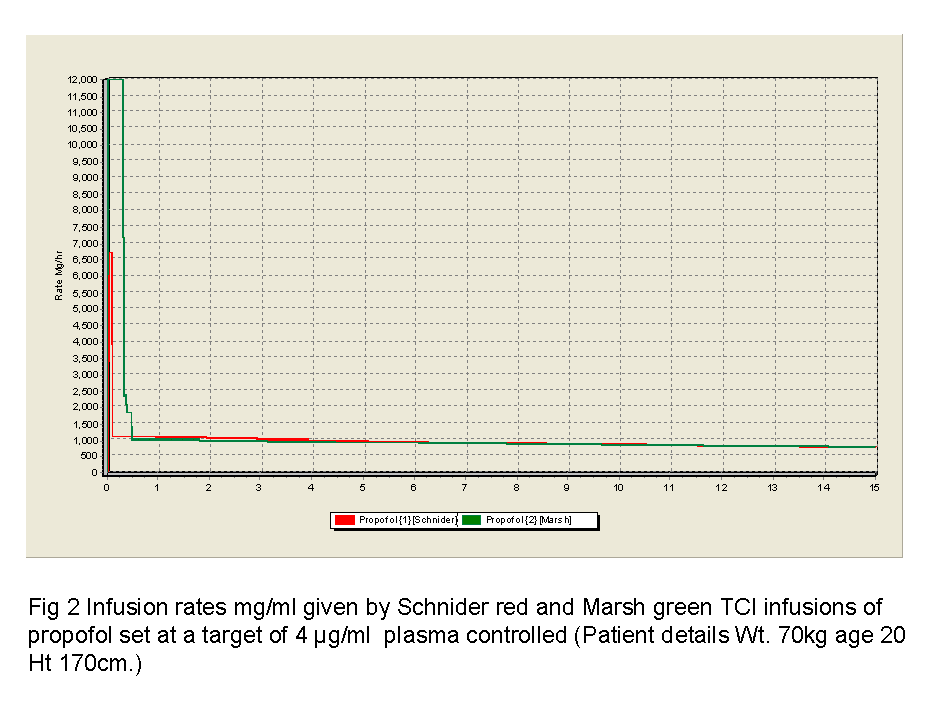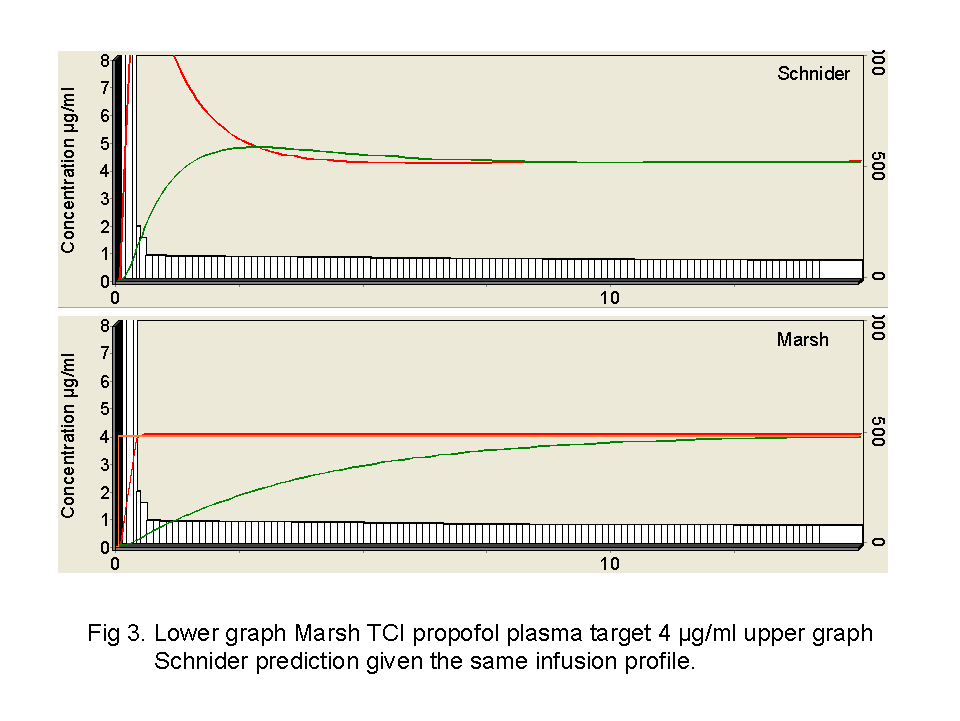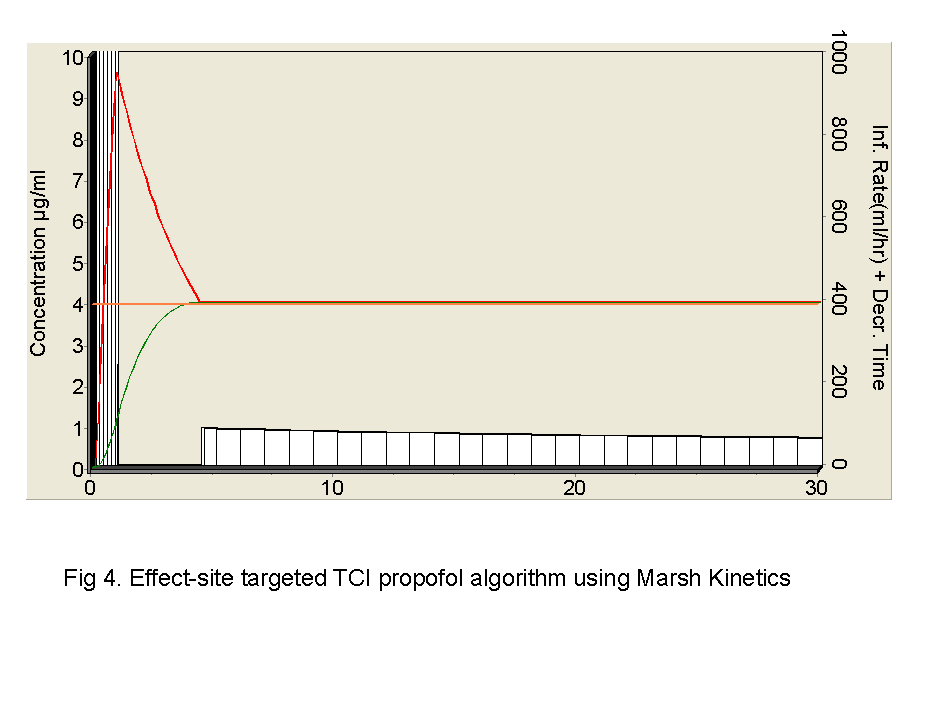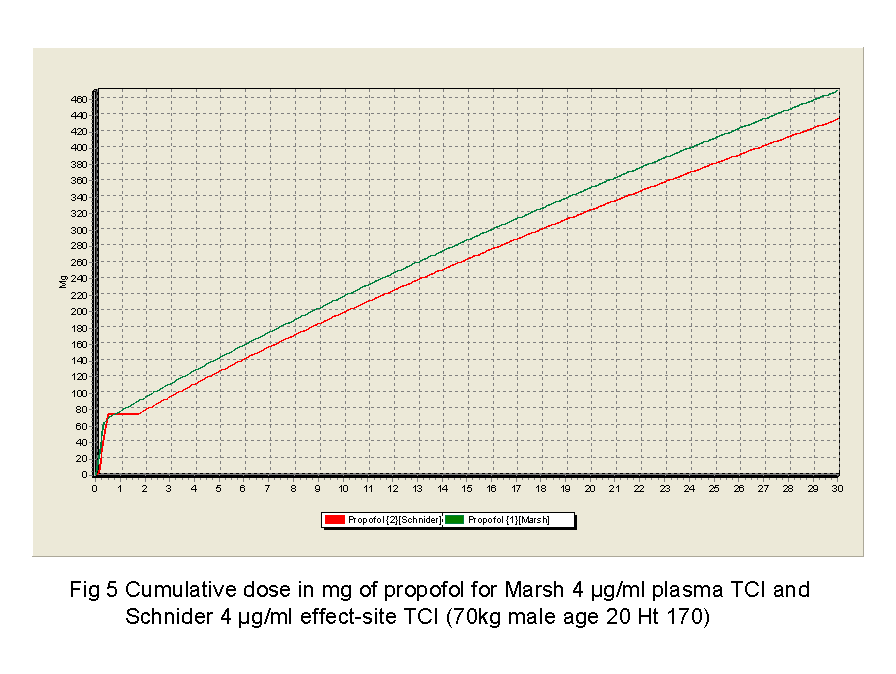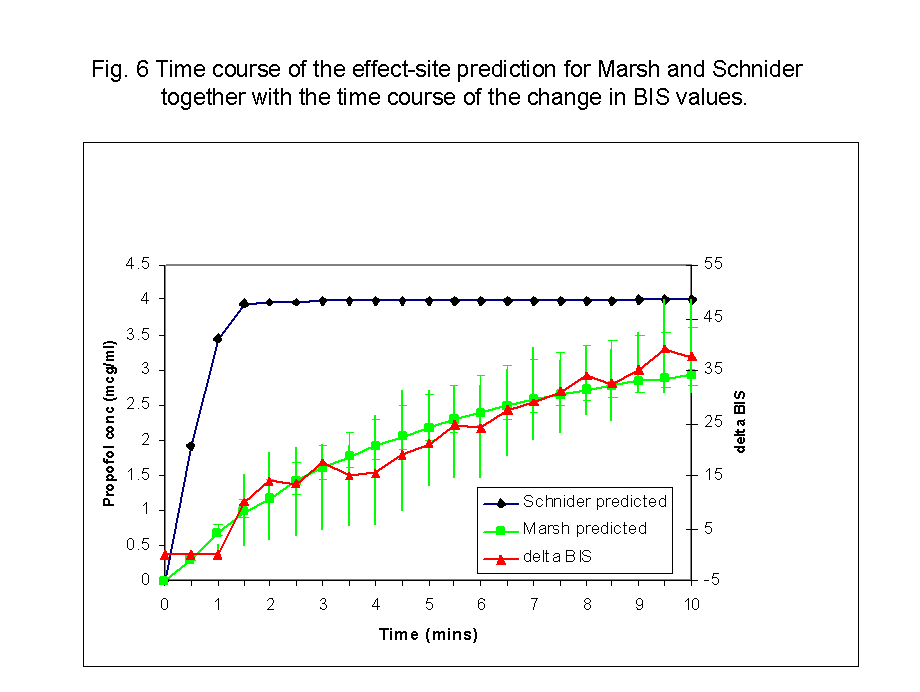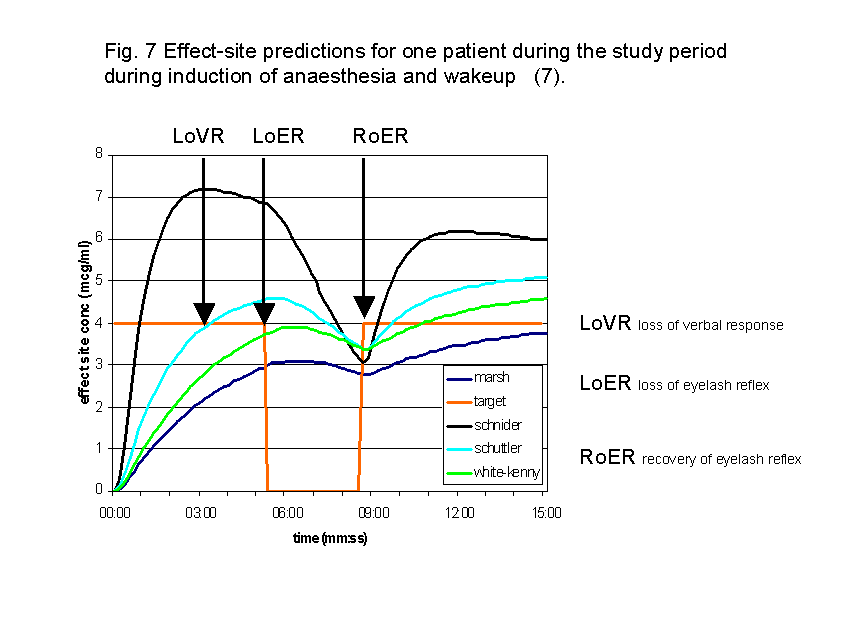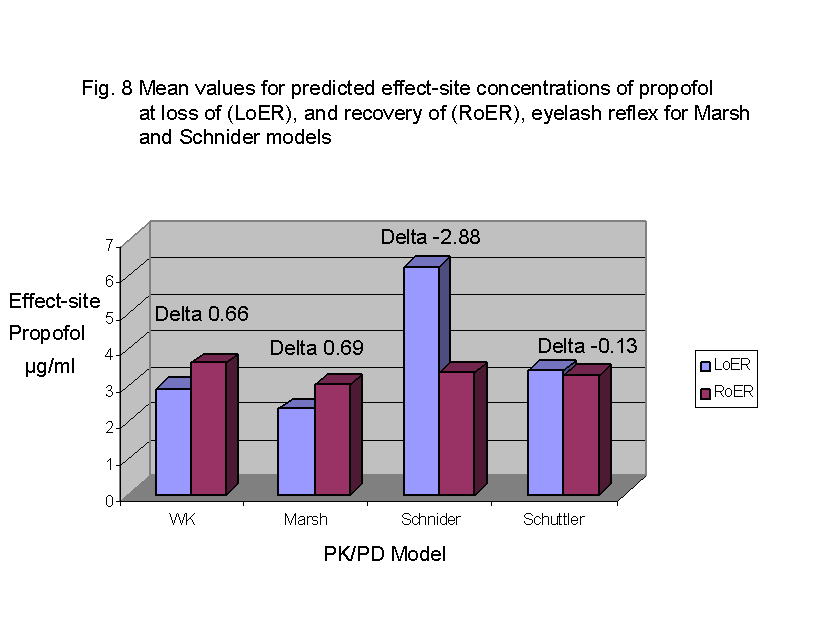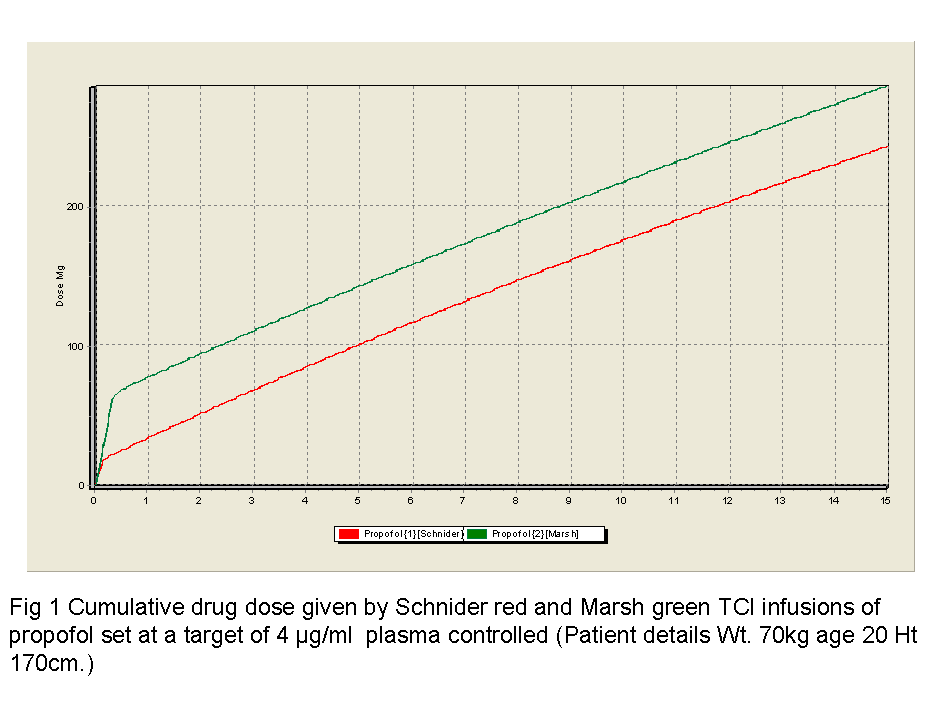
Choosing a pharmacodynamic model for clinical practice
N. Sutcliffe
The use of Target Controlled Infusions (TCI) for the delivery of Total Intravenous Anaesthesia (TIVA) has increased steadily since the introduction of the Diprifusor in 1996. It is probable that the increased use of TIVA has at least in part, been attributable to the ease of use afforded by TCI systems. Until recently the Diprifusor was the only commercially available device which delivered TCI and this was locked to the use of Diprivan by a syringe tag recognition system. The Diprifusor uses a pharmacokinetic/pharmacokinetic (PK/PD) data set developed in Glasgow known as the Marsh set (1).
At the time of development of the Diprifusor these kinetics represented the best available PK/PD model available for propofol. There was also considerable clinical experience of the use of TCI based on a prototype TCI devise using these kinetics. One limitation of the Marsh model is that it is a weight based algorithm with no adjustment for age or lean body mass. We know that this adult data set is unsuitable for use in children and there is a potential to overdose the obese and the elderly unless lower targets are selected for these groups.
A number of “newer” PK/PD models for propofol have been described with adjustment for age and lean body mass (LBM). This would on the face of it offer better prediction of blood and effect site propofol concentrations for an individual patient particularly in elderly patients.
However this has to be balanced against current practice. With over 20,000 Diprifusors in use world-wide, anaesthetists have learned to select lower targets for elderly and obese patients. Would it just cause confusion at this stage to introduce new models, so that the anaesthetist would have to relearn suitable initial target values in some patients? Further confusion may be caused in an institution with a mixture of pumps giving different infusion regimens when set on the same target concentration. Do these “new models” offer any real clinical benefit and have they been shown to be safe and effective in clinical practice?
There are 3 main models to consider, Marsh which is the data set in the Diprifusor, Schuttler (2), and Schnider (3). Many of the differences or similarities between these models can be explained by how they were derived and the philosophy surrounding there development. The Marsh kinetics were developed from and optimised for infusions. The model was based on venous blood samples; weight was the only co-variate, with no adjustment for age or LBM. Keo was calculated during infusion using mathematical iteration and Auditory evoked response (AEP) as the effect parameter. Schuttler incorporated data from the Marsh group plus data from other studies in an effort to adjust the parameters for age and weight. In practice drug delivery with this is similar to Marsh with less drug being given particularly during induction.
The Schnider model was based on arterial blood samples, and used both bolus dosing and infusions. The Keo calculation was taken from the time to peak effect after a bolus dose. The Marsh groups philosophy is to use venous sampling on the assumption that this allows “adequate mixing” in the central compartment (C1) which is weight adjusted; no attempt is made to model the transient high peaks in arterial drug concentrations seen after bolus dosing. The philosophy of the Schnider group is to assume a fixed small C1 for all patients and adjust the clearance for weight height and sex. Thus we can see why there may be some difference between these models. In essence the Schnider kinetics predict a much lower initial bolus dose when used to drive a TCI infusion compared to the other models. Figure 1 shows the difference in cumulative drug dose given by Schnider red and Marsh green TCI infusions set at a target propofol concentration of 4 µg/ml plasma controlled (patient details Wt. 70kg age 20 Ht 170cm. The Schnider gives less drug; the majority of the difference relates to the initial bolus dose, as illustrated by figure 2 which shows the same information as figure 1 expressed as infusion rates. If we now use the infusion algorithm from Marsh and calculate what the Schnider model would predict the blood and effect-site concentration to be then we see that Schnider calculates that Marsh under predicts initial blood concentrations but that both models predict similar blood concentrations after 10 minutes of infusion 4.2 vs. 4 µg/ml (see figure 3). We can also see from these 2 simulations, that because of the difference in the initial predicted blood concentrations and the more rapid Keo in Schnider, the effect-site equilibration is predicted to be much faster with Schnider than Marsh. We should be able to test this in clinical practice by looking at markers of effect-site concentration or clinical effect end points.
Effect-site Control TCI
The Diprifusor incorporating the Marsh model targets the blood or plasma concentration and displays the calculated effect-site concentration as added information for the anaesthetist. It is however, possible to modify the algorithm so that the effect-site is targeted. In this way the blood concentration is allowed to rise above the desired effect target to drive the drug into the effect-site faster. However the initial rapid infusion is tailored so as not to allow an overshoot in the effect-site concentration (see figure 4.). The potential advantage of this technique is faster titration of drug effect and therefore faster induction of anaesthesia. The clinical experience with Schnider has almost exclusively been in effect-site targeted TCI. With the release of commercially availably pumps with this algorithm built in the popularity of Schnider driven effect-site targeted TCI for propofol has been increasing in Europe, as a “more sophisticated approach” to drug delivery for propofol. However, if we examine figure 5 which shows the cumulative dose for both Marsh plasma targeted TCI at 4 µg/ml and a Schnider effect targeted TCI at 4 µg/ml, we can see that both regimens give approximately the same amount of drug. Thus if our experience is with Marsh in plasma TCI mode and we expect a rapid induction with effect-site targeted TCI we will be disappointed with the Schnider algorithm in this respect as it actually gives less drug to the patient than the Marsh Plasma TCI algorithm at the same target. This will be even more the case with older patients.
Clinical Studies
Our own clinical practice with sedation using Marsh TCI suggested a good degree of correlation between the time course of drug effect in clinical practice and that of the Marsh predicted effect-site concentration. Initial experimentation with the Schnider effect-site control algorithm also lead us to believe that the Schnider PK/PD model predicted a too rapid effect-site equilibration when compared to clinical end points in our patients. These observations lead us to perform a number of clinical studies comparing the effect-site prediction of the two models with both, effect-site markers such as Bispectral index (BIS) and clinical end points such as loss of and regaining of consciousness (4,5,6,7).
Effect-site Parameters
We compared the time course of effect-site prediction for both models with 3 different effect-site markers, the BIS, AEP and state entropy. Twenty patients were studied in each group the Schnider effect-site TCI algorithm set at 4 µg/ml was used to induce anaesthesia the effect-site parameter value was noted every 30 seconds. The PK/PD simulation software TIVA trainer was used to recalculate the predicted time course of the effect-site concentration for both models, given the infusion profile delivered to the patient. The time course of the Marsh effect-site prediction matched the time course of each of the effect-site parameters, better than that of the Schnider. Figure 6 shows these effect predictions for both models together with the associated change in the BIS values.
Clinical Endpoints
We performed an induction study in 60 patients* using Marsh plasma targeted TCI propofol set at 4-6 µg/ml, we recorded the time to loss of verbal contact and loss of eyelash reflex; at this point the infusion was targeted to zero and the time to return of eye lash reflex and verbal response was noted. The time course of the effect-site prediction for this infusion profile was simulated for 4 different PK/PD models, Marsh, Schnider, Schuttler, and White/Kenny (a model derived from Marsh and adjusted for Wt., age and sex). The effect-site predictions at loss of and return of the clinical end points were determined for each model using the TIVATrainer software.
The assumption being that these two values should be similar as they represent the transition between consciousness and unconsciousness. The patients were divided into an elderly group age over 65 and a younger group age less than 65. 30 patients were recruited in each group. Figure 7 shows the predicted time course of propofol effect-site concentration for each model during the study period for one patient. Figure 8 shows the mean predicted effect-site concentrations for each model at loss of and return of consciousness in patients less than 65 years of age. The Schuttler model showed the closest agreement between these two values. The Schnider Model was consistently the worst of all the models studied in this respect for both groups of patients. Kazama has studied the induction dose predicted by both Schnider and Schuttler compared with the actual induction dose at 2 different infusion rates of propofol. He found that the Schuttler model predicts the induction dose of propofol better than the Schnider (9)
Conclusions
Although the Marsh model has some deficiencies in respect of lacking adjustment for age and sex, it has been successfully and safely using for millions of anaesthetics world wide. The potential benefits of new models need to be balanced against the confusion such models may cause when introduced into clinical practice. Some of the clinical observations using Schnider to deliver propofol by effect-site TCI suggest that the predictive effect-site time course may be too rapid. More studies and more clinical experience are required with this model before accepting it as an improvement on the Marsh kinetics. One thing that is clear is that Schnider effect-site control will not deliver faster titration of anaesthesia when compared with Marsh plasma control TCI. The main difference between the 2 models is the initial bolus dose and infusion rates,
* Preliminary results presented (7)
Schnider giving less drug in almost all circumstances. However, during induction of anaesthesia most anaesthetists give a cocktail of drugs including opiates and
sometimes supplementary benzodiazepines. This often means that in clinical practice these adjuvants will make up for any shortfall in hypnotic dosage and mask these difference between the models. The fact that anaesthesia involves titration of drug delivery to effect means that, any small difference in actual drug delivery between models should not make any significant difference to the overall quality of the anaesthetic. One development which should make a difference to clinical practice is effect-site control of drug delivery. Unfortunately the current situation is particularly confusing in this respect since the Schnider kinetics suggest that we have been delivering effect-site control TCI whilst using the Marsh kinetics in plasma control; whilst the Marsh kinetics suggest that we still don’t have effect-site control when we use the Schnider kinetics in the effect-site control algorithm.
1. Marsh B, White M, Morton N, Kenny GN. Pharmacokinetic model driven infusion of propofol in children. British Journal of Anaesthesia 1991;67(1)41-48
2. Schüttler J, Ihmsen H, “Population pharmacokinetics of propofol” Anesthesiology 2000; 92:727-73
3. Schnider TW, Minto CF, Shafer SL et al. The Influence of Age on Propofol Pharmacodynamics Anaesthesiology 1999;90(6):1502-1516
4. A Hay E Jack K Litchfield N Sutcliffe “Effect Site Concentration using BIS on Induction of Anaesthesia with TCI Propofol.” presented as a poster at EuroSIVA spring meeting Lisbon 2004
5. Hay A, Jack E, Litchfield K, Sutcliffe N, McCormick M “Effect Site Concentration using EEG Entropy analysis on Induction of Anaesthesia with TCI Propofol.” presented as a poster at EuroSIVA spring meeting Vienna 2005.
6. McCormick M, Jack E; Hay A, Sutcliffe N. Effect site concentration using auditory evoked potentials on induction of anaesthesia with target controlled infusion of propofol. Anaesthesia. 61(1):85-86, January 2006.
7. Prinzlin J, Sutcliffe N, Engbers F. “ Predicted effect-site concentrations at loss of and return of consciousness” Presented at the EuroSIVA spring meeting Glasgow 2003.
8. White M, Kenny GN, “A modification of the Marsh Pharmacokinetic model” (personal communication GN Kenny).
9. Kazama T, Morita K, et al “Comparison of predicted induction dose with predetermined physiologic characteristics of patients and with pharmacokinetic models incorporating those characteristics as covariates.” Anaesthesiology 2003

